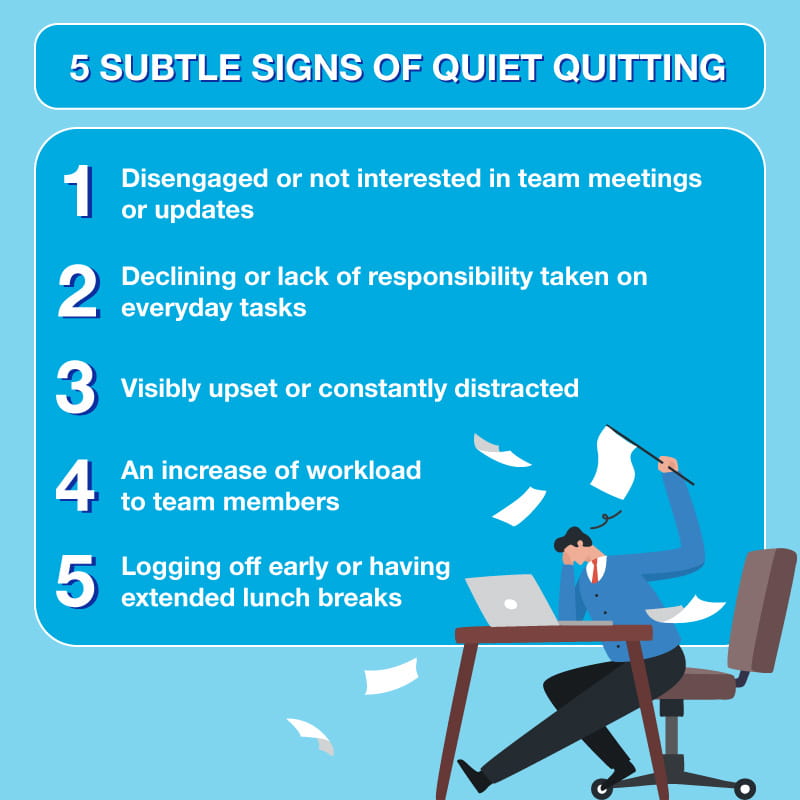
There’s no doubt that the Australian jobs market has undergone some big shifts in recent times, with one major trend being the ‘great resignation’.
Originally coined in the US, the great resignation refers to the very large number of workers who quit their jobs in the wake of the global COVID-19 pandemic. This phenomenon has already seen thousands of workers across Australia leave unfulfilling jobs, change careers, or focus on life and pursuits outside work.
It’s also led to the emergence of a new trend sweeping workplaces far and wide, known as ‘quiet quitting’. In this post, you’ll learn all about quiet quitting, including why people are doing it, how to identify the subtle signs, as well as the solutions to overcome this growing movement.
On this page, you’ll find:
- The growth of quiet quitting
- Why are Aussies quiet quitting?
- What are the signs of quiet quitting?
- Are there any solutions to quiet quitting?
- Other ways to keep staff engaged and motivated

The growth of quiet quitting
Quiet quitting is the practice of workers doing only what they’re paid for during business hours and nothing more. The phrase sparked conversation on social media sites like TikTok because it refers to staff members only doing the bare minimum without putting in extra time or effort than the requirements outlined in their job description.
Anecdotally, quiet quitters are mostly members of Generation Z, while industry research also points to a big proportion of millennials driving the trend. Indeed, a recent US survey reported HR professionals noticed 72 per cent of quiet quitting among 26-41 years old workers.
And it seems it’s not just the younger generations who feel this way. A recent study from Bloomberg showed that workers of all ages across different industries are less likely than before to go above and beyond at work. The viral trend has even taken stronghold in finance – once the industry with the most engaged workers, according to Bloomberg’s survey of over 9,000 US employees.
Why are Aussies quiet quitting?
There has been much research trying to pinpoint the reasons why quiet quitting has surged in recent times and COVID-19 appears to have something to do with it. The pandemic triggered burnout, stress, anxiety and falling engagement among workers.
Another factor that’s cited is the surge in remote working – another flow-on from the pandemic – which has shown workers that there are different ways of working that allow you to embrace your hobbies or take time out when needed.
The same research from the World Economic Forum also highlighted that some people are quiet quitting to care for family, take a career break, or to take advantage of working overseas enabled by advancement in technology.
But they’re not the only reasons. According to the latest Hays Salary Guide, Aussie workers are under many kinds of work-related stress, which often leads to burnout and disengagement. For instance, some 38 per cent of employees said they struggled to shut off from work when working from home, while almost a quarter (24%) reported that doing less overtime would positively impact their mental health.
Other factors in the mix are lack of career progression or job opportunities, stresses in personal life, as well as toxic work cultures and bad bosses. Given this backdrop, perhaps it’s no surprise that quiet quitting came along.
Indeed, the 2022 State of the Global Workplace report from Gallup showed only a dismal 21 per cent of employees were engaged at work, begging an important question – how can you tell?
What are the signs of quiet quitting?

It’s important to note that the above signs are only a general guide for employers and employees to look out for. Just because workers are displaying any of these signs, it’s not a guaranteed way of knowing if they’re doing the bare minimum at work.
There may be cases, for instance, where team members show signs of quiet quitting, but there’s more to the story such as family or personal challenges at home, or health reasons.
That’s why as a business leader it’s a good idea to reach out to staff if anything out of the ordinary is noticed. Not only can it help their situation, it may also be good for business.

Are there any solutions to quiet quitting?
Solving quiet quitting can be tricky. There’s no single solution and it can often take time for businesses to turn things around so workers feel motivated to ‘buy in’ to company culture. For leaders, some experts suggest undertaking employee listening programs like organisation-wide surveys that can identify corporate “experience gaps”. These are instances where organisations fail to meet employee expectations on the career journey.
Research also indicated that promoting a healthy work-life balance can help. That’s why it’s important for bosses and co-workers to respect any mental health days, out-of-office responses, employee holidays and after-hours time.
Another positive move could be for businesses to be more flexible on where work gets done, including how and when performance is managed.
The Hays Salary Guide echoed some of these findings, concluding measures likely to have a positive impact on employees’ mental health and wellbeing include flexible working hours (52%), hybrid/remote work (46%) and an improved office environment or culture (43%).
Other initiatives include leaders who consult with employees regularly (35%), paid mental health days (33%), additional team headcount (28%), and less overtime (24%). The survey also pointed to more contact with colleagues (22%) and workplace mental health support (12%) as notable initiatives that support employee engagement.
Other ways to keep staff engaged and motivated
It’s one thing to identify high-level solutions, it’s quite another to get it right on the ground. With that in mind, here are a few tangible moves leaders can make to nurture employee engagement in a bid to counteract quiet quitting.
First off, work hard to make your staff feel valued and appreciated. You’ve already lost if the only time you discuss employee progress and goals is during performance reviews. Make sure, by contrast, that you’re providing positive and constructive feedback.
Also, don’t neglect investment in employee development and wellbeing. This takes in both mental and physical health such as making sure staff workstations are set up ergonomically.





